
|
U. S. CIVIL WAR
PHOTOGRAPHS
|

|
BEAVER DAM CREEK
(PAGE 1 OF 2)
In the text, the icon  is a link to the definition of the word it marks. is a link to the definition of the word it marks.
Use your
browser's "back" button to return to the page.
| |
June 26, 1862
Estimated Casualties : :
CWSAC Battle Summary:
N.P.S. Park Sign:
|
1,700 total (US 400; CS 1,300)
1,842 total (US 361; CS 1,481)
|
Second of the Seven Daysí Battles. Gen. Robert E. Lee initiated his offensive
against McClellan's right flank north of the Chickahominy River. A.P.
Hill threw his division north of the Chickahominy River. A.P.
Hill threw his division , reinforced by
one of D.H. Hill's brigades , reinforced by
one of D.H. Hill's brigades , into a series of
futile assaults against Brig. Gen. Fitz John Porter's V Corps , into a series of
futile assaults against Brig. Gen. Fitz John Porter's V Corps , which was drawn up behind Beaver Dam Creek.
Confederate attacks were driven back with heavy casualties. Jackson's Shenandoah
Valley divisions, however, were approaching from the northwest, forcing Porter
to withdraw the next morning to a position behind Boatswain Creek just beyond
Gainesí Mill. , which was drawn up behind Beaver Dam Creek.
Confederate attacks were driven back with heavy casualties. Jackson's Shenandoah
Valley divisions, however, were approaching from the northwest, forcing Porter
to withdraw the next morning to a position behind Boatswain Creek just beyond
Gainesí Mill.
(Text Source: U.S. Gov't, National Park Service)
|
|
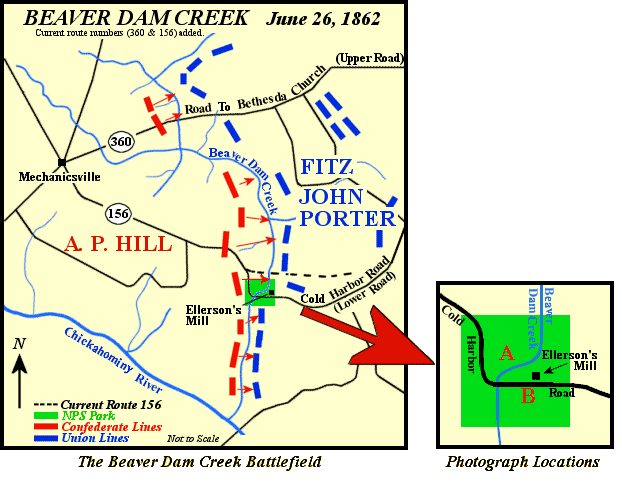
(The outtake shows the location of the photographs in this section.)
Report of Maj. Gen. George B. McClellan, U. S. Army, commanding Army of
the Potomac.
The position of our troops was a strong one, extending along the left bank
of Beaver Dam Creek, the left resting on the Chickahominy and the right in
thick woods beyond the upper road from Mechanicsville to Cold Harbor. The
lower or river road crossed the creek at Ellison's Mill. Seymour's brigade
held the left of the line from the Chickahominy to beyond the mill, partly
in woods and partly in clear ground, and Reynolds' the right, principally
in the woods and covering the upper road. The artillery occupied positions
commanding the roads and the open ground across the creek.
Timber had been felled, rifle pits dug, and the position generally prepared
with a care that greatly contributed to the success of the day. The passage
of the creek was difficult along the whole front, and impracticable for
artillery, except by the two roads where the main efforts of the enemy were
directed.
At 3 p.m. he formed his line of battle, rapidly advanced his skirmishers, and
soon attacked our whole line, making at the same time a determined attempt to
force the passage of the upper road, which was successfully resisted by
General Reynolds. After a severe struggle he was forced to retire with very
heavy loss.
A rapid artillery fire, with desultory skirmishing, was maintained along the
whole front, while the enemy massed his troops for another effort at the
lower road about two hours later, which was likewise repulsed by General
Seymour with heavy slaughter.
The firing ceased, and the enemy retired about 9 p.m., the action having
lasted six hours, with entire success to our arms. But few, if any, of
Jackson's troops were engaged on this day. The portion of the enemy
encountered were Chiefly from the troops on the right bank of the river,
who crossed near Meadow Bridge and at Mechanicsville.
The information in my possession soon after the close of this action
convinced me that Jackson was really approaching in large force. The
position on Beaver Dam Creek, although so successfully defended, had its
right flank too much in the air, and was too far from the main army to make
it available to retain it longer. I therefore determined to send the heavy
guns at Hogan's and Gaines' houses over the Chickahominy during the night,
with as many of the wagons of the Fifth Corps as possible, and to withdraw
the corps itself to a position stretching around the bridges, where its flanks
would be reasonably secure, and it would be within supporting distance of
the main army. General Porter carried out my orders to that effect.
It was not advisable at that time, even had it been practicable, to withdraw
the Fifth Corps to the right bank of the Chickahominy. Such a movement would
have exposed the rear of the army, placed as between two fires, and enabled
Jackson's fresh troops to interrupt the movement to James River, by crossing
the Chickahominy in the vicinity of Jones' Bridge before we could reach
Malvern hill with our trains. I determined then to resist Jackson with the
Fifth Corps, re-enforced by all our disposable troops in the new position
near the bridge heads, in order to cover the withdrawal of the trains and
heavy guns, and to give time for the arrangements to secure the adoption of
the James River as our line of supplies in lieu of the Pamunkey.
[Source: O.R.-- SERIES I--VOLUME XI, Part 1, Chapter XXIII, Page 54]
|
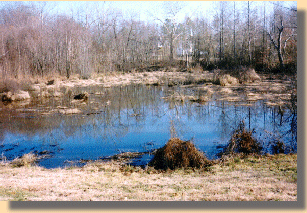
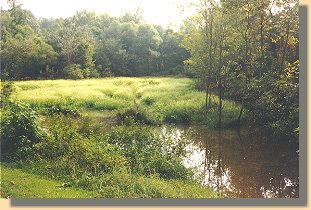
Beaver Dam Creek, January, 1998 (left) and September, 1998 (right).
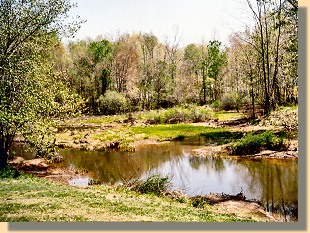
Beaver Dam Creek, Spring, 2005.
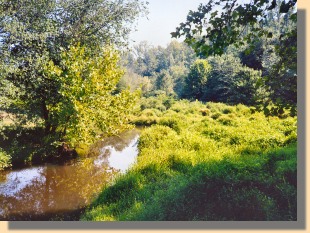
Beaver Dam Creek, Summer, 2008.
| |
The four photographs above were taken at the same location ("A" on the map,
above) from different directions. They show one of the places the Confederates
crossed Beaver Dam Creek under intense enemy fire.
|
|
PAGE TWO
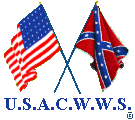 >
Civil War Photos
>
Richmond - Outlying Area
> Beaver Dam Creek
>
Page 2
>
Civil War Photos
>
Richmond - Outlying Area
> Beaver Dam Creek
>
Page 2
|
|








